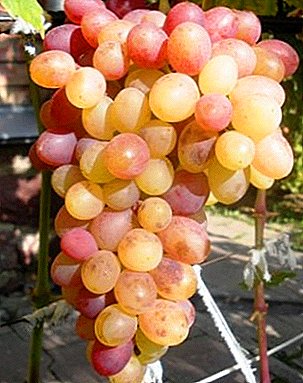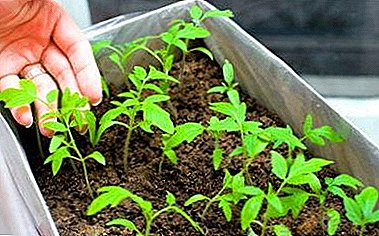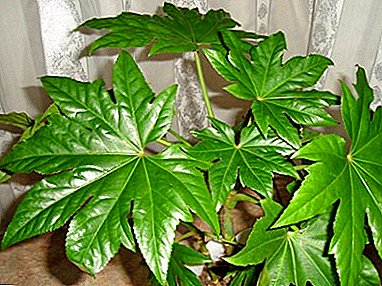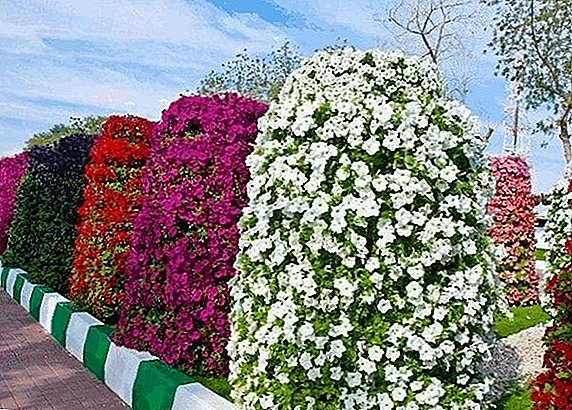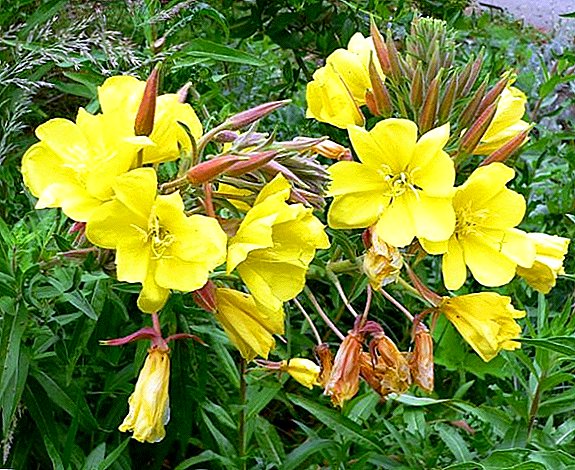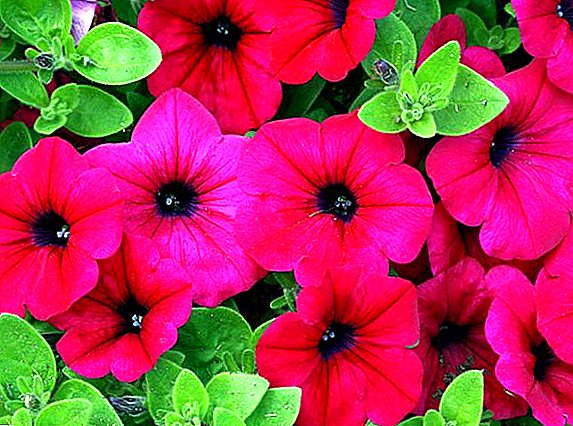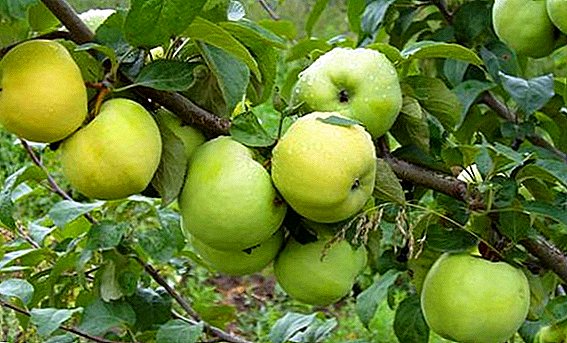 Many gardeners consider the Antonovka ordinary apple to be one of the most successful varieties for our latitudes. It combines the high quality of fruits and the relative unpretentiousness in terms of care. Let's consider its biological features and get acquainted with the requirements for planting and further care.
Many gardeners consider the Antonovka ordinary apple to be one of the most successful varieties for our latitudes. It combines the high quality of fruits and the relative unpretentiousness in terms of care. Let's consider its biological features and get acquainted with the requirements for planting and further care.
Breeding history
"Antonovka" is an old Central Russian apple tree variety. There is an assumption that this is a spontaneous hybrid of cultivated and wild apple trees, which began its distribution from Kursk province in the XIX century.
For the first time the plant was described in 1848 by N. I. Krasnoglazov in his work "Rules for fruit growing in open ground, greenhouses, greenhouses, etc.".  In the same century, "Antonovka" some experts began to consider a variety, uniting a number of related varieties.
In the same century, "Antonovka" some experts began to consider a variety, uniting a number of related varieties.
On the basis of Antonovka, modern specialists have deduced several other popular varieties of the variety: A. sweet, A. half-foot, A. white, and several independent varietal variations obtained by crossing Antonovka ordinary with other apple varieties. (for example, "Cherry", "Imrus", "Bogatyr", "Friendship of Peoples").
Did you know? 20-25% of the mass of apples is air, thanks to which they do not drown in water.
Biological features
Speaking about the biological characteristics of the variety, we must proceed from the characteristics of the apple tree and its separate fruits, because when it is grown, not only apples are important, but also the peculiarities of crown growth on the site, not to mention caring for the plant. 
Tree description
The apple tree "Antonovka ordinary" grows to a height of 7 m, characterized by a round and slightly crown extended upwards.
In young trees, the main branches are more elevated to the trunk, and only over time they fall to the sides. The shoots are covered with brown bark and oval-shaped bright green leaves with jagged edges and a wrinkled surface.  During the flowering period, quite large white flowers with a pinkish tinge and petals tight to each other appear on the tree.
During the flowering period, quite large white flowers with a pinkish tinge and petals tight to each other appear on the tree.
With age, the crown of "Antonovka ordinary" from the oval shape becomes more spherical, and the intervention of gardeners has nothing to do with it.
See also other varieties of apple trees: "Uslada", "Melba", "Candy", "Sun", "Currency", "Berkutovskoe", "Northern Sinap", "Sinap Oryol", "Dream", "Zhigulevskoe".
Fruit Description
Most of the rounded fruits of the variety are quite large in size, often with pronounced ribs in the lower part. The color of apples varies depending on the specific ripening period: at the beginning they are green-yellow, and during long-term storage they turn completely yellow.  The flesh of apples is juicy and sweetbut at the same time it contains a slight sourness, which distinguishes the variety Antonovka from many others.
The flesh of apples is juicy and sweetbut at the same time it contains a slight sourness, which distinguishes the variety Antonovka from many others.
Important! In some cases, the flesh has a creamy tide, but otherwise is no different from other fruits.Typically, fruits are characterized by an average value, reaching only 120-150 g. On average, they contain 14.6% of vitamin C, about 10% of sugars and 0.8-0.9% of acid.
Since the apples sit tightly on thin or medium stalks, the probability of shedding the crop is almost nil. The rind of the fruit is smooth, and the overall appearance gives them excellent commercial quality.
Pollination
“Antonovka” is perfectly pollinated by other varieties, so planting several apple trees in the garden is quite logical.
This feature significantly increases the amount of the harvest, especially if the pollinators for "Antonovka ordinary" serve varieties "Anise", "Welsey" or "Pepin saffron".
Gestation period
The variety is attributed to early-winter because the fruits ripen in September-October. The specific time when Antonovka ripens depends on the exact location of the tree growth.  For example, in the Moscow Region, harvesting is started at the end of October, while in the steppe Ukraine or in the Krasnodar Territory they can harvest in late summer or early autumn.
For example, in the Moscow Region, harvesting is started at the end of October, while in the steppe Ukraine or in the Krasnodar Territory they can harvest in late summer or early autumn.
However, you should not plant a variety in the southern regions with a very hot climate, since the fruits will be smaller and not so heavy.
Yield
Active fruiting of the apple tree begins only 5-7 years after planting the seedling, and at first the harvest will be regular.  Older trees do not bear fruit every year and are capable of producing up to 0.5 tons of apples per crop. On average, with one apple can be collected 300-400 kgalthough there are cases in history when only one adult “Antonovka ordinary” brought up 1000 kg apples.
Older trees do not bear fruit every year and are capable of producing up to 0.5 tons of apples per crop. On average, with one apple can be collected 300-400 kgalthough there are cases in history when only one adult “Antonovka ordinary” brought up 1000 kg apples.
Check out the best varieties of apple trees for growing in different regions: the Urals, Siberia, the North-West, the Moscow region.
Transportability and storage
The apples picked from the tree can be successfully stored for up to three months, transferring transportation well. But in order that they can be consumed fresh as long as possible or processed for conservation, it is worth remembering a few recommendations:
- do not shake apples from the treeas in the places of impact the fruits will deteriorate very quickly;
- for long-term storage harvest must be taken a little earlier than usual (until it reaches the technical term of maturity);
- containers for reusable before picking apples need to spray antifungal solution and dry thoroughly;
- putting the apples into the shipping container try to avoid hitting each other and on the walls of the box;
- before placing the crop in a warehouse, storage or cellar all fruits are sorted, getting rid of specimens even with minimal damage to the peel;
- sorted fruits are stored in plastic or wooden boxes, filled with shavings, or wrapped in separate paper sheets or tracing paper;
- the temperature of the air in the storage should be within 1.4-1.8 ° C.
 In addition, it is useful to organize good ventilation in a room with a crop, which will increase the shelf life of apples.
In addition, it is useful to organize good ventilation in a room with a crop, which will increase the shelf life of apples.Winter hardiness
Apple-tree varieties "Antonovka ordinary" has a high level of winter hardiness and is not afraid of winter frosts, which is also a positive thing when planting and leaving it.  However, this is more true for adult trees, but young saplings should be additionally protected from snowless winters or early frosts, mulching them with horse humus (placed in a near-stem circle in a small layer) or wrapping the shtrak covering material.
However, this is more true for adult trees, but young saplings should be additionally protected from snowless winters or early frosts, mulching them with horse humus (placed in a near-stem circle in a small layer) or wrapping the shtrak covering material.
Important! Any protection chosen for shelter must pass through water and air, which means that ruberoid or film should not be used.In the future, this method can be used as an alternative to whitewash.
Disease and pest resistance
With proper care (seasonal whitewashing, protection of the trunk from rodents and frosts, timely loosening of the soil, etc.), “Antonovka ordinary” is almost unresponsive to the most characteristic diseases of the apple tree.  In particular, it is highly resistant to scab, passing this quality when crossed to new varieties.
In particular, it is highly resistant to scab, passing this quality when crossed to new varieties.
Application
In addition to its amazing fresh taste, Antonovka apples are widely used for various culinary purposes. They are used to prepare drinks (various compotes, juice, wine), as well as jam, jam, marmalade, and even marmalade.
For culinary purposes also use plum, raspberry, strawberry, strawberry, medlar and pear.Better than other varieties, Antonovka ordinary fruit are suitable for urinating, after which they can be used as a component of salads or snacks.
Some housewives add this fruit to sauerkraut, which gives it an original taste. In addition, apples of this variety are great for baking, stuffing poultry and even cooking fresh salads.
Did you know? It is better to eat all apples together with a peel, as the maximum quantity of useful substances (in particular, cellulose) is contained immediately under it.
Rules for planting apple seedlings
Apple tree "Antonovka ordinary", which is described above, looks attractive not only in the photo, because if you believe the numerous reviews of gardeners, it is quite profitable in terms of cultivation. Possessing a high level of resistance to various adverse factors, this variety will not require large physical costs from you. It will be enough basic knowledge of planting a tree and further features of its cultivation.
Optimal timing
You can plant an Antonovka on your plot in spring or even autumn, the main thing is to have time before bud break or 2-3 months before the first frosts appear (so that the tree can take root well).
Autumnal planting is considered preferable if it is carried out in black earth soils, in all other cases it is better to wait for spring.
Choosing a place
Like all other apple trees, Antonovka prefers well-lit places, since with insufficient light exposure, it is possible to reduce the sugar content of the crop or decrease its volume.  Also pay attention to the soil moisture and the possibility of stagnant water, which the tree simply does not tolerate. If on your site there is a similar probability, then take care of good drainage in advance, or place the seedling on the hill.
Also pay attention to the soil moisture and the possibility of stagnant water, which the tree simply does not tolerate. If on your site there is a similar probability, then take care of good drainage in advance, or place the seedling on the hill.
For good growth and abundant fruiting, groundwater is allowed at a level of 2-2.5 m from the surface.
Make sure that the soil in the selected place is breathable and does not have an increased level of acidity (to pH 5.6-6.0). At elevated rates, you can add a little lime or dolomite flour to the planting substrate.  It is best to use sandy, loamy and floodplain soils for the full development of the apple tree, although it feels good on leached chernozem.
It is best to use sandy, loamy and floodplain soils for the full development of the apple tree, although it feels good on leached chernozem.
Site preparation
If you decide to plant your “Antonovka” in the spring, you need to prepare the soil at the chosen place in the fall (approximately in October).
During the autumn planting, the soil is dug up 1-2 months before planting the seedling. The first time, digging the plot, try as carefully as possible to select all the weeds, because the young plant is difficult to cope with them.  Also, do not forget to apply fertilizer: for 1 m² there should be 8-10 kg of peat mixed with 100 g of superphosphate and 30-40 g of potassium sulfate, about 6 kg of compost or manure, and also 35-45 g of potassium salt.
Also, do not forget to apply fertilizer: for 1 m² there should be 8-10 kg of peat mixed with 100 g of superphosphate and 30-40 g of potassium sulfate, about 6 kg of compost or manure, and also 35-45 g of potassium salt.
Important! The area under sabotage should be dug up in the fall, keeping whole lumps of earth.If you have just begun to develop a new, barren plot, it is necessary to begin its cultivation at least one year before planting the garden.
Planting pits are also excavated in advance: during the autumn planting - in 1-1.5 months, and in the spring - in the fall. For the apple tree "Antonovka ordinary", as, indeed, for many other varieties, the size of the pit varies between 80-100 cm (width) and 80-90 cm (depth).
These values depend not only on the size of the plant’s root system, but also on the composition of the soil, since on heavily depleted lands, in addition to the roots, it is necessary to put a nutrient substrate into it, due to which the plant can develop normally in the next few years.  By the way, removing the upper part of the soil, which is always more fertile, pour it in one direction, while the lower, infertile layer should be sent to the other. When planting apple trees, you must use only the top layer. For convenience, mark the landing site with a peg, drawing a circle with a diameter of 0.8-1 m in front of the digging around it.
By the way, removing the upper part of the soil, which is always more fertile, pour it in one direction, while the lower, infertile layer should be sent to the other. When planting apple trees, you must use only the top layer. For convenience, mark the landing site with a peg, drawing a circle with a diameter of 0.8-1 m in front of the digging around it.
Seedlings preparation
It does not matter where you took your seedlings: you prepared them in advance or bought them in finished form, before planting you need to inspect them again, even if you are absolutely sure of their suitability.
Also do not forget to make a control cut - test for freezing. If browning or yellowing of tissues is observed, you can be sure that the root system of the seedling has suffered from the winter frosts. In this case, you need to cut the roots to intact tissue.  In the same way, do with rotten, dried or broken roots, performing all the manipulations only with a sharp knife with a clean blade.
In the same way, do with rotten, dried or broken roots, performing all the manipulations only with a sharp knife with a clean blade.
It is likely that such sanitary pruning has already been done in the fall, then it is not necessary to repeat it, since callus infusions have already appeared on the root slices.
Dried roots are placed in the water for 1-2 days before planting, and if you notice that besides the roots, the bark on the stem and the branches have wrinkled, then the whole plant should be “soaked”. After the specified time, the bark should be leveled, but if this did not happen, then another sapling will have to be found - this one is no longer suitable.
Learn about planting grapes, cherries, walnuts, peaches, pears and cherry plums.For better survival in a new place, the roots of a young plant are useful to dip into a soil talker (not just clay): we put nutrient soil in a large bucket or barrel and dilute it with water to sour cream.
Growth regulators will also help speed up rooting. For example, you can dissolve two tablets of heteroauxin in 10 liters of water and put the roots of an apple tree into the solution for 1-2 hours before planting.
Process and scheme
When planting several apple trees in your garden, it is important to leave a certain distance between them, which depends on the estimated size of the tree in adulthood.
"Antonovka ordinary" refers to vigorous varieties, so the seedlings are placed after 3-4 meters, observing a distance of 5-6 meters between rows.  As soon as you prepare the landing pits and fill them with the substrate, hammer in the center straight and barked peels 120 cm long. Also do not forget to loosen the nutrient mixture and pour it closer to the peg in the form of a small hill. On top of it, fertile soil is poured without fertilizers, a layer of 5-8 cm.
As soon as you prepare the landing pits and fill them with the substrate, hammer in the center straight and barked peels 120 cm long. Also do not forget to loosen the nutrient mixture and pour it closer to the peg in the form of a small hill. On top of it, fertile soil is poured without fertilizers, a layer of 5-8 cm.
Later, during direct planting, the same substrate is poured onto the roots, which is a mandatory measure in order to avoid burn of the root system as a result of direct contact with fertilizers. An Antonovka sapling is installed on a mound so that the root neck rises 8-10 cm above the ground level (for convenience, you can put it across the board pit or shovel). When the loose soil shrinks, the sapling will go down a little, just taking up its normal position.
All the roots should be evenly spread over the mound, and when filling the pit, periodically shake the seedling so that the void between them is filled with the substrate. As soon as the root system is completely hidden under the ground, compact it with your foot, pressing the foot along the stem radius.
At the border of a completely filled pit, fill the ground with a roller about 12 cm in height, and then pour the sapling abundantly, depositing liquid in the resulting hole (at least two buckets per plant).  Watering is necessary even in rainy weather, as this procedure helps to fill the voids between the roots and normal soil subsidence. If there are ravines - immediately fill them with earth.
Watering is necessary even in rainy weather, as this procedure helps to fill the voids between the roots and normal soil subsidence. If there are ravines - immediately fill them with earth.
Better survival of seedlings will contribute to the mulching of the soil in the circle near the trunk with a 5-8 cm layer of humus, peat powder, rotted manure or sawdust.
In order for the sapling to take a more stable position and not swinging in the wind, it should be tied to a peg with soft twine (in the form of a figure eight).
Features of seasonal care for apple trees
"Antonovka ordinary" - non-capricious varietyHowever, when caring for trees, certain requirements must be observed. Let's find out what you need apples for rapid growth and abundant fruiting. 
Soil care
In the first seven years after planting the apple tree, it is necessary to regularly remove grass and any other plants from the soil, performing weeding each time after watering.
As for the latter, it is performed twice a week, pouring no less than a bucket of water under each tree. In a very dry season, the regularity of irrigation, as well as the amount of applied fluid, increase.  During the spring and autumn digging of the soil in the circle of the circle, you can feed the apple tree with mineral compounds: superphosphate, potassium chloride and wood ash.
During the spring and autumn digging of the soil in the circle of the circle, you can feed the apple tree with mineral compounds: superphosphate, potassium chloride and wood ash.
To preserve moisture in the soil and protect the plant from drying out of the root system, mulching of the soil with sawdust, humus and rotted manure will help (the optimal layer thickness is 8 cm).
Fertilization
Fertilizers for Antonovka are applied three times a year: after the snow melts (that is, in early spring when digging the soil around the tree), before starting its flowering and during the formation of fruit on the branches.  Any mineral fertilizers are suitable for top dressing, but if you use organic matter (for example, slurry or chicken droppings), do not forget that it must ferment and be diluted with water in a ratio of 1:10.
Any mineral fertilizers are suitable for top dressing, but if you use organic matter (for example, slurry or chicken droppings), do not forget that it must ferment and be diluted with water in a ratio of 1:10.
Important! Always carefully follow the dosage, since oversupply can damage the root system.
Fight against diseases and pests
Despite its high resistance to diseases and pests, during periods of strong epiphytotics, the susceptibility of Antonovka to scabs may increase to average values, therefore, to protect it (and at the same time itself) from possible problems, it is very important to use preventive treatments with fungicide formulations.
Against diseases of the apple tree use: "Antrakol", "Delan", "Poliram", "Topsin", "Skor".Get rid of the moth and other pests will help: "On the spot", "Fastak", "Kemifos", "Detsis", "Calypso", "Karbofos".Chlorophos, pure Entobacterin, or a mixture of Entobacterin and chlorophos can be used to protect against the moth and other caterpillars.
 Preventive measures to combat diseases include spring processing "Antonovka" 3% Bordeaux liquid and spraying the soil with a 0.3% solution of "Nitrafen". After the appearance of the first buds, the tree can be treated with 0.5% copper oxide.
Preventive measures to combat diseases include spring processing "Antonovka" 3% Bordeaux liquid and spraying the soil with a 0.3% solution of "Nitrafen". After the appearance of the first buds, the tree can be treated with 0.5% copper oxide.Cropping and crown formation
Since the second year of life, the main component of Antonovka ordinary care is the constant pruning of weak or dried branches and the periodic formation of the tree crown. The trunk of an apple tree can also be shortened, with the removal of 1/3 of all new branches.  With the onset of fruiting, shortening side shoots does not stop, although the intensity of the process should decrease slightly. Upon reaching the tree twenty years old, cut from ½ to 1/3 perennial annuli.
With the onset of fruiting, shortening side shoots does not stop, although the intensity of the process should decrease slightly. Upon reaching the tree twenty years old, cut from ½ to 1/3 perennial annuli.
The more of them on the tree, the more to be removed. In addition, do not forget about the annual pruning, which includes the removal of damaged, dry, curves, diseased and close to the rest of the branches.
Protection against cold and rodents
In the first three years after planting, to protect young plantings from freezing of the root system, they are spud for the winter, covering the soil with a 10-12 cm layer of rotted compost or humus.  In addition, to protect the trunk from rodents and other pests, it needs to be treated with chalky solution or lime washed (used for older trees). Before the first frosts, the trunk is also tied with sacking or roofing felt, and for better protection against mice, it is additionally protected with lapnik or mesh.
In addition, to protect the trunk from rodents and other pests, it needs to be treated with chalky solution or lime washed (used for older trees). Before the first frosts, the trunk is also tied with sacking or roofing felt, and for better protection against mice, it is additionally protected with lapnik or mesh.
On this, perhaps, everything. Now you know about the peculiarities of growing an Antonovka ordinary apple tree and without problems you can achieve a good harvest of sweet-sour apples.



